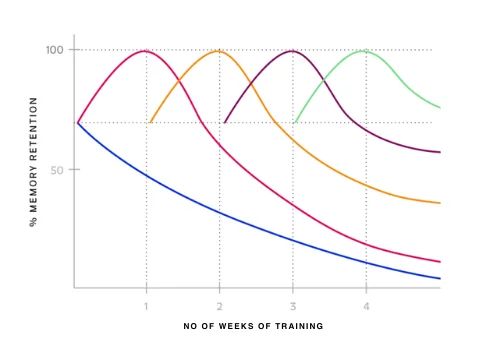
Successful employee onboarding: The science, benefits and tricks
Inductions for new starters can cover organization structure, HR procedures, health and safety, equipment overviews, job requirements, training and development programmes, meetings with colleagues and more. New starters can’t be expected to remember all of that in one go, though – our brains simply aren’t geared up for it. But, it’s important. Successful employee onboarding significantly improves employee morale, performance and retention, all of which have a positive effect on your organization’s bottom line.
Despite that, organization onboarding processes typically take a traditional, classroom-based approach to learning, with information given to new starters in big chunks. This is down to time and cost pressures, of course, but it’s counterintuitive because it costs more time and money in the long run through a lack of effectiveness and efficiency. But how can we make sure the onboarding we deliver is effective? And what makes it effective?
SCIENCE
For employee onboarding to be successful, new starters need to both take in and retain a large amount of information. We’ve known as far back as 1956 that we learn lots of info better when we break it up into small chunks. American psychologist George A. Miller termed this approach “chunking” and it’s the basis for what we today call “Microlearning”. Even further back in 1885, meanwhile, German psychologist Hermann Ebbinghaus had hypothesized that we forget up to half of what we learn within a matter of days and continue to forget information over time, albeit at a decreasing rate. The “Ebbinghaus Forgetting” Curve also suggested that the rate of forgetting is reduced each time newly learned information was reviewed, implying that knowledge retention can be improved with repeated exposure to information. This last insight underpins the modern-day learning technique Spaced Repetition.

APPROACHES
Microlearning
Microlearning breaks topics down into small pieces. It aids the learning process because it suits the brain’s ability to learn short, easily consumable segments, rather than overwhelming it with large volumes of new information in one go. For onboarding, microlearning could be delivered to a new starter’s work computer at their desk, or via a mobile app.
Personalized Spaced Repetition
Taking Microlearning a step further, learners can be tested on a topic, with the information they’ve failed to retain or recall shown to them again for reinforcement and information they have retained not shown again, or shown at rarer intervals. This is known as Spaced Repetition. By adapting it to a user’s needs, it becomes Personalized Spaced Repetition. Testing can be web or app-based, while prompts can be sent via email or as push notifications.
E-learning
There are a number of employee onboarding benefits to hosting learning materials and activities online. To begin with, new starters can access them from anywhere at any time, meaning learning is made more convenient and more effective. It also means they can revisit materials or activities to refresh their knowledge as required. Elsewhere, online platforms typically make it easy to track learner performance, meaning areas of weakness can be identified and addressed.
EMPLOYEE ONBOARDING BENEFITS
There are lots of benefits to ensuring the best possible employee onboarding process and they’re not just limited to benefits for the employer. Here are some of the biggest benefits for employers, employees, and customers.
Benefits For employers
- Acceleration: Employees are brought up to speed more quickly, adding value sooner.
- Productivity: Workforce performance is improved, meaning productivity increases.
- Retention: Employees are happier and more engaged, making them less likely to leave.
For employees
- Confidence: Employees have more belief in their abilities, are more comfortable in their roles and are happier.
- Performance: Employees are better equipped to deliver their roles and do so to a higher level.
- Belonging: Employees feel more engaged and more a part of the organization.
For customers
- Quality: Customers receive a better quality of product or service, improving company reputation.
- Responsiveness: Employees are able to respond to customer queries more quickly and with better answers.
- Communication: Employees can speak with customers more comfortably and more authoritatively
EMPLOYEE ONBOARDING TIPS
Start before they start
Don’t wait until a new employee’s first day to begin the onboarding process. When you invite candidates to interviews, you should give them information about the company and the role. Not only does this begin getting them up to speed, it builds enthusiasm and makes a strong first impression.
Involve everyone
Although a new starter will only be working in one role on one team, they are still a part of the organization as a whole and they need to feel like that is the case. Introducing them to different employees and teams is crucial for this. Other teams should also provide overviews of how they will work with new starters and the working processes involved. More broadly, it’s important to give starters a sense of the company’s culture, customers and place in the industry.
Keep it continuous
Delivering onboarding as a one-off event rather than an ongoing process not only makes it harder for new starters to remember everything they are told but puts them under more pressure to do so. By making it an ongoing or “revisitable” process, employees can continually refresh any areas of knowledge weakness that they think need addressing. What’s more, a greater sense of engagement and belonging is developed.
EASILY ONBOARD NEW STARTERS
Enhancing your onboarding initiatives with Wranx is a sure fire way of increasing productivity. Your new starters will quickly and confidently feel equipped to start working independently which will add value to your organization.
The benefits of onboarding your new starters with Wranx are:
– Quick and effective onboarding on products, policies, procedures and services
– Improved productivity
– Increased staff retention
– Enhanced confidence
– Increased performance
– Increased sense of belonging
To find out more about how Wranx can enhance your onboarding program click here.
